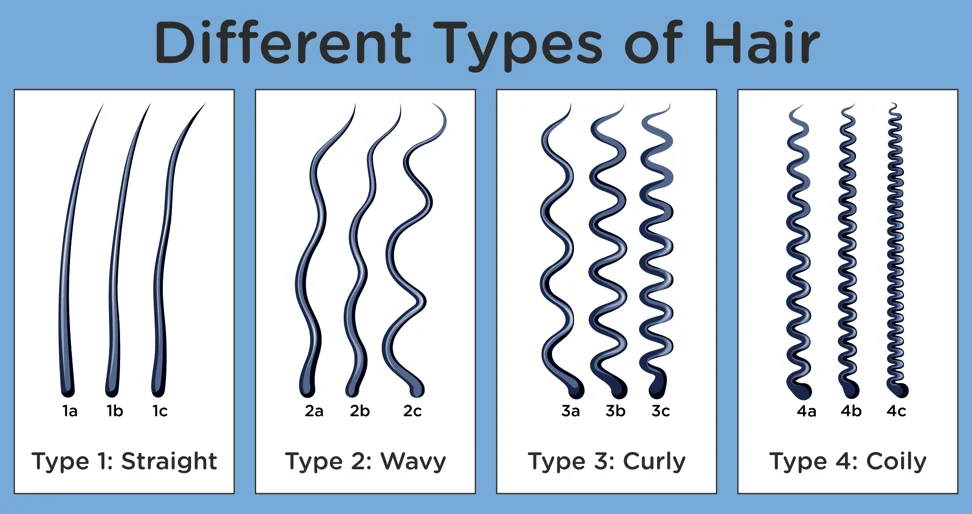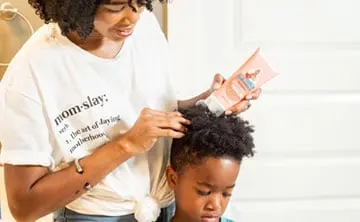Everything You Need to Know About Caring for Your Child’s Curly Hair
Managing your little one’s mane can be a real task no matter what, and curls, though gorgeous and enviable, can definitely add to the unruliness. If you have a kiddo with curls, this article is the best place to start! From long, gentle waves to short, textured coils, we’re covering all the basics you need to know for how to tame toddler curls in a way that builds your child’s confidence and keeps you one cool, calm, and collected parent (because that’s what we all are, right?).
Types of Curly Hair
Let’s begin by breaking down the types of curly hair. Yes, there are actual hair classifications based on the curliness of the hair. For our science lovers, hair curliness is determined by the shape of the hair follicle, a fancy word for the body part that surrounds the base of each strand of hair.

Straight hair is easy to identify and has its own category, while curls are defined across three different categories - 2, 3, and 4 - each of which is then further organized by an addendum A, B, or C. Type 2 hair is wavy with a 2A being the loosest and a 2C registering as a deep S-shaped wave. Type 3 hair is truly curly with the hair registering in ringlets of different diameters, while Type 4 hair is shaped in a coil or zig-zag pattern.
Generally, as one moves from categories 1 to 4, and similarly from A to C, the hair becomes increasingly prone to dryness as the scalp’s oils have difficulty moving down thicker hair shafts and tighter coils. On the flip side, these tresses also tend to be more versatile, holding more styles and for longer periods.
By understanding your child’s specific curl type – or quite often types - you can more easily choose the right hairstyles, tools, and products to get the definition you’re looking for. Buh-bye, frizz!
Stay Confident
Before we get into tips and tricks for managing your toddler’s curly hair, let’s begin with one giant positive affirmation: you can do this! If you’ve only ever experienced straight hair, you may be surprised or even frustrated by the work involved in the care and keeping of curls. Even those who’ve taken care of their own curls might find managing their toddler’s to be a whole different story.
So, if you find yourself getting discouraged with flyaways or frizz, first grant yourself the gift of taking one long, deep breath. We want kids with curly hair to feel confident, so it’s important to resist speaking negatively about your child’s hair even in passing as this can actually damage their self-esteem. Instead, reframe the situation: remind your curly hair child how lucky they are to have such beautiful, voluminous locks, and share that you’re glad you have the opportunity to learn something new together.

Meka Harrell | @xomekaharrell
How to Care for Curly Hair
Now, for those really looking to cut to the chase on how to maintain curly hair for toddlers, this section is the do-not-miss! If after reading you want to dive even deeper, visit here to find additional styling resources for your curly hair baby.
Day-to-day Care:
First, lightly spritz the hair with water, and then use a wide-toothed comb to gently untangle hair without disrupting the natural flow of the curls. If your child’s hair is fine, this may be as far as you need to go. However, for thicker hair, you may also want to add a light mousse or even a leave-in conditioner such as Johnson’s® Curl Defining Leave-In Conditioner If you’re going for an up-do, use soft hair-ties instead of plastic elastics, and no matter how many cute ponytail hack videos you’ve seen involving a vacuum, please just stick with the wide-tooth comb!
Bath-time Care:
While your busy toddler may need daily baths, it’s important to avoid over-shampooing their curly hair as this can cause excessive dryness leading to both frizz and brittleness. When you do shampoo every few days, choose products meant for their age and specific hair type such as Johnson’s® Curl Defining Shampoo, and always follow with a hydrating conditioner. For excessively dry hair, you may want to even condition between your less frequent shampoos. Lathering conditioner thoroughly, especially at the ends as this part of the hair is receiving the least amount of natural moisturizing oils from the scalp. And don’t forget: the optimal time to detangle with your fingers is while the conditioner is working its magic! Follow with a thorough cool water rinse.
Drying Care:
Gently squeeze excess water with your hands or a cotton t-shirt as Team2Moms brilliantly shares in this How To video. Whenever possible, allow your toddler’s curls to air dry into their natural shape. Apply a light leave-in conditioner and, if necessary, a gentle detangling spray. If you’re in a rush and need to blow dry, be sure to keep the heat on low, use a wide tooth comb, and add the diffuser extension to your blow dryer in order to minimize frizz.
Nighttime Care:
Believe it or not, a notable level of hair damage can occur to your toddler’s curly tresses at night. To minimize breakage and frizz, you want to minimize friction. One of the best ways to do this is to use silk instead of cotton pillowcases. Alternatively, if your toddler is comfortable with it, you can gently cover their hair in a silk turban.
Using the Right Products:
Just as different skin types and skin-sensitivity levels benefit from different products, so too will your toddler’s curly hair appreciate a personalized approach. In fact, using the wrong products for your curly hair baby can actually create more problems than solutions. For example, applying a thick curl gel meant for the tight coils of 4A hair is going to weigh down the loose waves of fine 2A hair and require earlier washing. Similarly, products meant for adult hair often don’t translate well to younger hair even if they’re made for the same follicle shape, so look for those that are made specifically for babies or kids.
When it Comes Time for a Haircut
There are so many adorable hairstyles for curly hair kids and getting the right cut is, of course, a big part of meeting your family’s haircare goals. Not every hairstylist is well versed in cutting curly or textured hair, so you’ll want to do your homework to pick a salon with stylists who truly understand the unique needs of your toddler’s curls. When in doubt, ask friends or family who have experience with hair like your child’s for personal recommendations or peruse Instagram for stylists in your region to see their digital portfolios!
